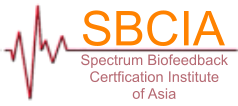Elaborate Science dating back to 1920s
Neurofeedback and biofeedback are scientific developments in the field of Mind-Body holistic health science. It embraces Eastern mindfulness techniques with elaborate science.
Our behavior, cognition, emotion and social responses are reflected in our physiological (or bodily) responses such as heart beat (ECG), brain waves (EEG), muscle tension, skin temperature, and etc. The reverse is also true that our bodily processes affects our feelings and cognition.
The above are studied in the fields of psychophysiology and physiological psychology:
- Psychophysiology studies how our feelings and thoughts (brain centric) affects health and diseases (body centric).
- Physiological psychology studies how our bodily processes, which is determined by our health, disease and bodily functions (body centric), affects our feelings and thoughts (brain centric).
The sciences behind neurofeedback/biofeedback and Eastern mindfulness are deeply entrenched in both fields of psychophysiology and physiological psychology. Both field are very broad and encompasses knowledge from the fields of brain, biological, computer, medical and neurocybernetics sciences.
Biofeedback has a long history which started in the 1920s when Dr. Edmund Jacobson (Harvard Medical) introduced progressive relaxation. Jacobson noticed a correlation between stress and disease conditions, and that stress can be measured by muscle tension. He developed an equipment to measure muscle tension and used it as a scientific way to train relaxation through biofeedback.
Neurofeedback started in the late 1950s when Dr. Joe Kamiya (University of Chicago) showed that one can be trained to produce Alpha brain waves (EEG) through feedback. Dr. Barry Sterman (UCLA) showed that one can be trained to produce stronger SMR brain waves through feedback, and in doing so can reduce the frequency and severity of seizures in epileptic patients. In a significant number of cases, the seizures stopped for more than two years. Dr. Joel Lubar (University of Tennessee) published milestone papers showing that neurofeedback is as effective as medication for children with attention deficit hyperactive disorders (ADHD).
Benefits of Neurofeedback and Biofeedback
Over the last century, research and clinical applications using neurofeedback and biofeedback indicated that when we learn mindfulness techniques to self regulate of bodily responses, we benefit enormously from it in three ways:
- It can help prevent illness and diseases (preventive health)
- It can help in recovery (intervention)
- It can help improve out performance (peak performance)
These techniques are non-invasive and safe, and its effects can be log lasting.
Where can one acquire such knowledge and skills?
These knowledge are very specialized and not commonly taught in standard curriculum. To pursue this field of knowledge, one will have to find a university that offers such curriculum. Usually, it is offered at the post-graduate level. As such it is difficult for most people who are interested in this field to acquire good knowledge.
SBCIA is established to address this need, to offer courses and skills training in the field of psychopysiology and physiological psychology.
In addition, SBCIA also engages in research and development (in-house and through collaboration with research institutions) to deepen the knowledge in these fields.
It looks simple, but ….
More and more people in the general public are now aware of the enormous the benefits of Neurofeedback and Biofeedback, especially for health interventions. This has led to the opening of many centers that offer Neurofeedback and Biofeedback interventions or services in the Asia Pacific. However, many of them do not have the relevant health science background and training.
The field of neurofeedback and biofeedback looks simple. As such many jump into the business of providing the service without proper training and guidance for financial gains. Without the right knowledge and skills, they will not be able to produce effective results. The lack of knowledge also leads to exagerations and empty promises by the untrained provider.
SBCIA was established to promote excellence in the field of neurofeedback and biofeedback so that the public can have access to quality neurofeedback/biofeedback services, and to safeguard the practitioners/researchers’ credentials.
Certified SBCIA practitioners go through rigorous training. You can see from the training curriculum that the certified practitioners goes through scientific rigors and many hours of supervised practicum to ensure that they are equipped with:
- Good knowledge in the field of psychophysiology and the science behind neurofeedback/biofeedback
- The skills needed to carry out a good training session (At least 100 hrs of mentoring) and case reviews
- Able to implement good clinical practice
- The support network they need for to do well (learning from each other and cross referring of clients for optimal results)
- Continuous education (by way of CE or further postgraduate degrees) to keep up with developments in the field
SBCIA also promotes collaboration between practitioners and researchers and R&D to encourage further development of equipment and knowledge in the field of neurofeedback and biofeedback. For this purpose, SBCIA has collaborative agreement with:
- Spectrum Learning Pte Ltd (Singapore)
- Universiti Teknologi Petronas (Malaysia)






